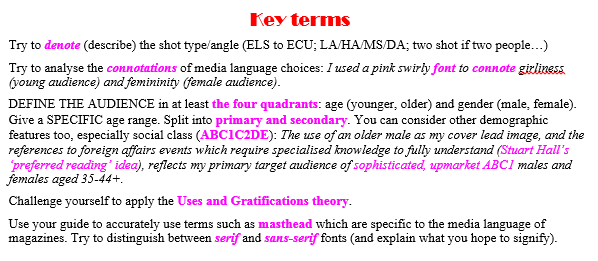Media coursework, and real-world media production, always requires a clear definition of the target audience:
- marketing a media product requires carefully selected advertising
- the audience of a TV show/channel (the ad breaks between programmes), or a movie (trailers), magazine (posters) etc needs to be similar to that targeted by the movie otherwise a LOT of money will be wasted!
- (TIP: magazines especially will offer detailed breakdowns of their readership [audience] on the publisher website as otherwise advertisers wouldn't pay - it would just be a random gamble without that information!)
- the text's media language + production choices will be shaped by target audience: you won't cast a mainly 40+ cast if you want to appeal to a youth audience; you won't include sexual or violent content or swearing that would lead to a UK BBFC age rating of 18 if you want to target a wide mainstream audience
- audience will always be split into two: primary and secondary (a secondary target audience is often older)
- we can also consider mainstream or niche appeal
- we would usually define at least an age range, gender(s) and social class (ABC1C2DE) - sophisticated, complex texts are often aimed at ABC1s, while simpler texts might be aimed at a less educated and less wealthy C2DE audience
- applying specific terms and theories like uses and gratifications, or linked narrative concept such as narrative enigma, is important
- media productions always reflect business thinking, so we get terms like the four quadrant strategy
 |
| Here's a more detailed BBC summary |
...









